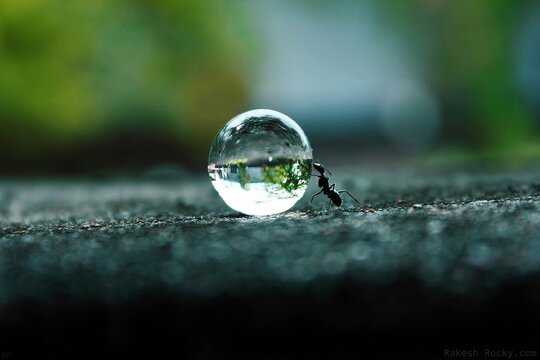I've read the story, I think it's a good story, but if you think it through, its plausibility is debatable.
I don't recall if the writer ever said exactly how big the robots were. I was picturing them as maybe 1 foot tall, i.e. much bigger than 1 mm. The closer they are to normal size, the less dramatic any scaling effects.
As others have noted, some things would be fairly obvious, like objects would fall too fast, water puddles would be too thick, the air would seem more viscous. You'd probably notice some square/cube effects, like hot objects would cool off too fast, and you could put more weight on a table or chair without it collapsing. If you had the equipment and expertise and measured the speed of light you could prove it definitively. I don't know how chemists determined the number of atoms in a mole, but if you could reproduce that you could prove it. Etc.
We'd have to ask how far the builders went to deal with such issues. Maybe they didn't give the robots real water but some chemical that behaves in a way that "looks right". (And of course if the robots drink it, they're programmed to think it tastes like water.) Presumably the robots are built so that their strength, speed, etc "feels right". The acceleration of gravity would be tough to work around as long as Tiny Town is on the surface of the Earth. But if you get most things to feel right, maybe nobody notices a few odd things, or if they do, they write it off.
Of course, the whole point of the story was that people just woke up one morning in their robot bodies in this artificial world. Presumably they had no reason to doubt that this was not just another day. So ... how odd would things have to be before you started sayng, "Hey, this is weird"? Sure, someone with scientific expertise who suspected he had been miniaturized like this could think of dozens of experiments to test the theory. But would your everyday experiences be enough to make you ask the question? If you were shrunk to 1 mm, I suspect they would be. But if shrunk to 1 foot? Maybe not. It's really hard to say.
Like if I woke up one day and noticed that, say, a book I dropped fell faster than it should, would my first thought be, "My consciousness must have been uploaded into a miniaturized robot!"? More likely I'd say, "Hey, that's weird. Is that normal? Is there something funny about this book? Oh well, anyway, got to grab some breakfast and get to work ..." Even if there were many things, I'd probably think, "Wow, I'm just really slow today" or "Maybe I should see a doctor" or whatever before I'd think of being turned into a miniature robot. And remember they only had one day to think about it before their brains were reset and they started the day over.
I suppose we could postulate that the robots are all programmed not to notice any discrepancies. They could be programmed to think that the speed at which objects fall is what they've always seen before and this is perfectly normal, etc. In which case the answer would become, It's impossible to tell, because you're programmed not to.
When I read the story I wondered: if the builders of Tiny Town had no moral qualms about uploading people's consciousness into these robots and using them for these experiments, why not just cordon off a real town of real people and do similar experiments? Indeed they wouldn't have to cordon it off, just run their different advertisements and observe what happens. Well, okay, with actual people they couldn't do the daily reset to get a controlled experiment. But it would seem a whole lot cheaper and easier. If they have the political pull that they can requisition the bodies of all the people killed in this explosion and upload their consciousness, surely they have the political pull to get whatever laws they need passed to let them run their advertising campaigns in one little town. Etc.


4
Note: compare with this story where the effects were explored in detail. And of course Asimov's Fantastic Voyage!
– JDługosz – 2016-04-25T16:51:39.9032I too read and enjoyed this story after someone posted it in the Sci-Fi SE. – WorseDoughnut – 2016-04-25T18:39:30.283
20Reading all the unspoilerized parts of the questions very effectively gives away the spoilerized part (AFAICT not having read the story). If you don't want to spoil the story, don't refer to it. (You can instead say "in a story I'm not naming to avoid spoiling it,..." and include the relevant part of the a synopsis.) – msh210 – 2016-04-25T20:20:45.147
19Giant dust. I doubt they'd be able to make your tiny town 100% dust-free, you'd be seeing dust-specks the size of trees everywhere. – Darrel Hoffman – 2016-04-25T22:28:19.713
Story here – zipzit – 2016-04-26T01:31:39.353
Wouldn't you know when you try to go on a drive around the countryside and hit the enclosure wall after a few hours? – Superbest – 2016-04-26T01:48:53.763
@Superbest: The existence of an enclosure wall would be evidence that you're not in "the real world", but not that you had been miniaturized; see this, this, and others. (I seem to recall encountering similar themes in at least one SF&F story, and The Twilight Zone (and other shows, ranging from Star Trek (remember the holodeck?) to Supernatural) have addressed this trope as well.)
– Peregrine Rook – 2016-04-26T05:40:57.4739When you meet a fly or an ant you'll know! :P – Max – 2016-04-26T11:04:14.097
9 [2009] Movie have something similer IMDB
– lal – 2016-04-27T07:09:54.4371Michael Crichton's posthumous book Micro gives a whole host of surprises for its shrunken protagonists. Jumping, falling, liquids and many more. Check it out. – Adi Shavit – 2016-04-27T15:29:07.663
You can only access worldbuilding on stack exchange if you <= 1mm... :P – DarcyThomas – 2016-05-02T04:52:23.120
Just measure. You can weight yourself or just measure something else like atoms. Also: When you have no blood you're a robot. And because you werent a robot before you know that something has changed – BlueWizard – 2016-05-08T18:11:49.920